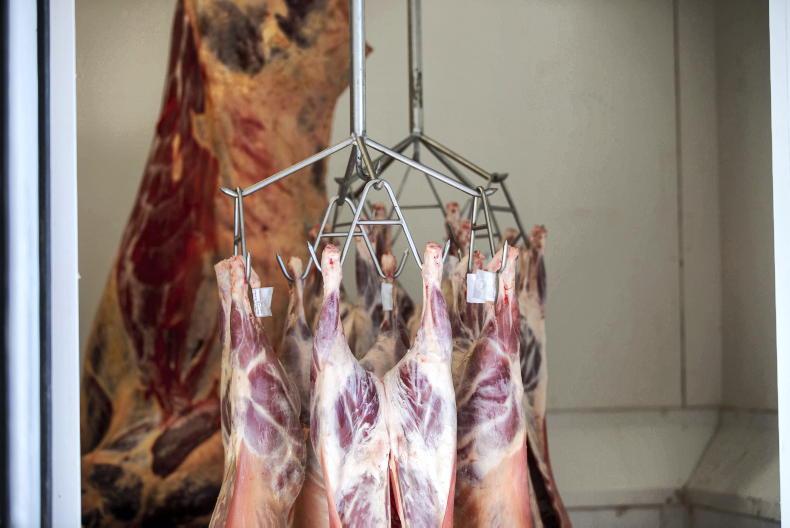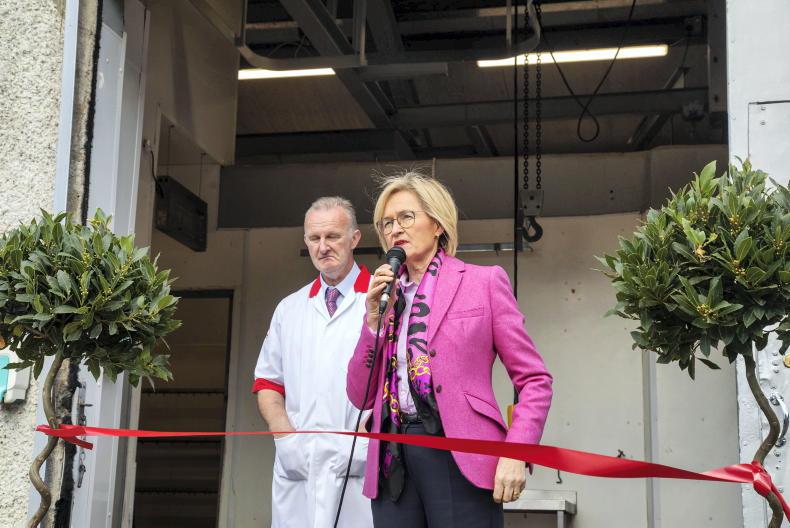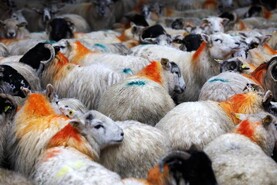Butcher Martin Commins from Ardee, Co Louth, made the decision to reopen the abattoir situated on his farm in 2020 after witnessing changes in consumer thinking on food and cooking during the COVID-19 lockdown.
The unit had been originally opened by his father Kevin in 1965, but the operation was wound down in 2008 “between one thing and another”.
“Well, it all happened with COVID. We had the first lockdown, we were extremely busy, all the restaurants were closed and people were back home cooking,” Commins told the Irish Farmers Journal on Monday at the formal reopening of the abattoir.
“It was always bugging me why we spent the money on it and why we didn’t utilise it a bit more.”
Renovation costs
Renovation costs amounted to a reasonable €21,000 as the facility had undergone an upgrade in the mid-80s. No funding supports were available for him to carry out these works.
With the first cattle put back through the line in February 2021, the abattoir is killing around six heifers and 35 lambs a week, supplying his own butcher shop in Ardee, as well as doing some freezer work for local farmers.
All cattle and sheep are sourced within a maximum radius of 15km from the Commins’s farm and abattoir, with some of his own stock slaughtered only a short walk from the field.
“It’s always heifers, we wouldn’t really be looking at doing bullocks. We would be looking for a nice continental with a bit of flesh on her there or an Angus-cross with a bit of continental in it,” he added.
“You need a bit of volume, a bit of muscle. The continentals help us with the yield as well, having that muscle there.”
Traceability
Supplier traceability information, including tag numbers, herd numbers, farmer names and farm addresses, are displayed in the butcher shop to provide customers with a transparent product and to emphasise the local nature of the small-scale abattoir.
The higher levels of animal welfare associated with these shorter journeys and doing all slaughter work by hand help meat quality, Commins said.

Heifers and lambs are killed weekly at the small-scale operation, with Commins supplying his own butcher's shop and killing for a few other craft butchers. \ Claire Nash
“We hang as well for a fortnight to three weeks, depending on flesh cover. When buying, we can tell a lot by eye. We know the farms they’re coming from too.
“The furthest would be 10km, maybe 15km. We only buy local and that’s what the customer wants.”
The butcher said the regulations that must be followed are necessary and ultimately to the benefit of all, also noting that he found local authority vets to be easier to work with now compared with his pre-closure dealings with them.
“The vets have been very good to us and worked with us, not against us. It felt like back in the day, they would be working against you. They were shifting the goalposts.”
Craft butchers
There are only around 75 small-scale abattoirs still operating in Ireland, according to the Associated Craft Butchers of Ireland’s Dave Lang.

Ireland's European Commissioner Mairead McGuinness formally reopened the abattoir. The unit had been operating since 2021. \ Claire Nash
“Well, this is kind of going against the trend. Martin decided to reopen the abattoir after almost 15 years. The trend was for abattoirs to close, but we are seeing a resurgence now,” said Lang.
The craft butchers’ group president Jack Molloy stated that Commins had differentiated himself from larger-scale beef processors by providing a unique product which customers would be willing to pay for.
“From farm to fork, they have a product that is absolutely traceable back to origin.”
Butcher Martin Commins from Ardee, Co Louth, made the decision to reopen the abattoir situated on his farm in 2020 after witnessing changes in consumer thinking on food and cooking during the COVID-19 lockdown.
The unit had been originally opened by his father Kevin in 1965, but the operation was wound down in 2008 “between one thing and another”.
“Well, it all happened with COVID. We had the first lockdown, we were extremely busy, all the restaurants were closed and people were back home cooking,” Commins told the Irish Farmers Journal on Monday at the formal reopening of the abattoir.
“It was always bugging me why we spent the money on it and why we didn’t utilise it a bit more.”
Renovation costs
Renovation costs amounted to a reasonable €21,000 as the facility had undergone an upgrade in the mid-80s. No funding supports were available for him to carry out these works.
With the first cattle put back through the line in February 2021, the abattoir is killing around six heifers and 35 lambs a week, supplying his own butcher shop in Ardee, as well as doing some freezer work for local farmers.
All cattle and sheep are sourced within a maximum radius of 15km from the Commins’s farm and abattoir, with some of his own stock slaughtered only a short walk from the field.
“It’s always heifers, we wouldn’t really be looking at doing bullocks. We would be looking for a nice continental with a bit of flesh on her there or an Angus-cross with a bit of continental in it,” he added.
“You need a bit of volume, a bit of muscle. The continentals help us with the yield as well, having that muscle there.”
Traceability
Supplier traceability information, including tag numbers, herd numbers, farmer names and farm addresses, are displayed in the butcher shop to provide customers with a transparent product and to emphasise the local nature of the small-scale abattoir.
The higher levels of animal welfare associated with these shorter journeys and doing all slaughter work by hand help meat quality, Commins said.

Heifers and lambs are killed weekly at the small-scale operation, with Commins supplying his own butcher's shop and killing for a few other craft butchers. \ Claire Nash
“We hang as well for a fortnight to three weeks, depending on flesh cover. When buying, we can tell a lot by eye. We know the farms they’re coming from too.
“The furthest would be 10km, maybe 15km. We only buy local and that’s what the customer wants.”
The butcher said the regulations that must be followed are necessary and ultimately to the benefit of all, also noting that he found local authority vets to be easier to work with now compared with his pre-closure dealings with them.
“The vets have been very good to us and worked with us, not against us. It felt like back in the day, they would be working against you. They were shifting the goalposts.”
Craft butchers
There are only around 75 small-scale abattoirs still operating in Ireland, according to the Associated Craft Butchers of Ireland’s Dave Lang.

Ireland's European Commissioner Mairead McGuinness formally reopened the abattoir. The unit had been operating since 2021. \ Claire Nash
“Well, this is kind of going against the trend. Martin decided to reopen the abattoir after almost 15 years. The trend was for abattoirs to close, but we are seeing a resurgence now,” said Lang.
The craft butchers’ group president Jack Molloy stated that Commins had differentiated himself from larger-scale beef processors by providing a unique product which customers would be willing to pay for.
“From farm to fork, they have a product that is absolutely traceable back to origin.”








 This is a subscriber-only article
This is a subscriber-only article










SHARING OPTIONS: